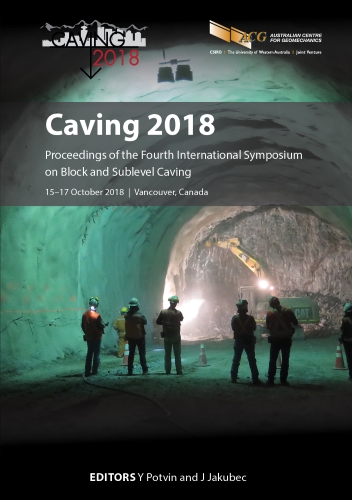Underground roadway design considerations for efficient autonomous hauling

|
Authors: Thompson, RJ; Malekzehtab, H |
DOI https://doi.org/10.36487/ACG_rep/1815_23_Thompson
Cite As:
Thompson, RJ & Malekzehtab, H 2018, 'Underground roadway design considerations for efficient autonomous hauling', in Y Potvin & J Jakubec (eds), Caving 2018: Proceedings of the Fourth International Symposium on Block and Sublevel Caving, Australian Centre for Geomechanics, Perth, pp. 337-350, https://doi.org/10.36487/ACG_rep/1815_23_Thompson
Abstract:
Whilst considerable time and effort is expended on loader and truck haulage system selection and optimisation for an underground operation, comparatively less effort is applied when considering the design and maintenance management of the roadways on which the system is intended to operate. These roadways or declines should be considered an asset, and should, in conjunction with the vehicles using them, be optimally designed and their routine maintenance predicted, planned and managed accordingly. Ad hoc or empirical approaches to roadway design are generally unsatisfactory because of the potential for either overdesign or specification of short-term low-volume roads, or conversely and more typically, underdesign leading to excessive operating and road maintenance costs, premature failure and significant safety and productivity impacts. The interaction of the truck or loader with the roadway running surface will directly influence the productivity, cost efficiency, and critically, safety of the system as a whole. This is true for both manual and autonomous operations. However, with autonomous systems, the roadway itself becomes all the more critical to the success of these type of operations; not only in relation to mine operators’ requirements for safer and more efficient and predictable haulage systems, but also in response to autonomous vehicle manufacturers’ requirements for a more predictable and controlled operating environment. This paper presents a brief summary of fundamental roadway design concepts, followed by a review of current approaches to underground roadway design, from both structural (layerworks) and wearing course (running surface) perspectives. The design and technological challenges associated with providing a safe, predictable and affordable roadway for autonomous underground mine vehicles is then examined as a basis for evaluating the contributions that engineered roadway design and management can deliver to large-scale bulk and autonomous underground mining operations.
Keywords: roadway design, decline, pavement design, hauling, underground mining, autonomous
References:
Carrick, K, McLean, M & Davidson, JK n.d., Use of Asphalt Emulsions in Underground Mines, McAsphalt Industries Limited, Toronto, viewed 20 April 2018,
Caterpillar n.d., ‘Asphalt reclamation paves way for efficient underground haulage’, Viewpoint Magazine, no. 2, viewed 9 April 2018,
Cooper, A 2008, Modelling Truck Performance in a Spreadsheet, internal document, Snowden Mining Consultants, Perth.
Department of Transport 1996, TRH4 (1996) Flexible Pavement Design, viewed 12 January 2018, available at
Pidwerbesky, B 2004, ‘AustRoads pavement design’, Mechanistic Design and Evaluation of Pavements 2004 Workshop, viewed 12 January 2018,
Seedsman, R, Logan, A, Cocks, G & Nicholls, B 1994, Underground Roads Manual: Construction and Maintenance, Australian Coal Associated Research Program, Queensland.
Theyse, HL, De Beer, M & Rust, F 1996, ‘Overview of the South African mechanistic pavement design analysis method’, Transportation Research Record, vol. 1539, pp. 6-17,
Thompson, RJ 2011, ‘Design, construction and management of haul roads’, in P Darling (ed.), SME Mining Engineering Handbook, Society for Mining, Metallurgy and Exploration, Englewood, pp. 957–976.
Thompson, RJ & Visser, AT 1996, ‘Towards a mechanistic structural design method for surface mine haul roads’, Journal of the South African Institution of Civil Engineers, vol. 38, no. 2, pp. 13–21.
Thompson, RJ & Visser, AT 2006, ‘Selection and maintenance of mine haul road wearing course materials’, Transactions of the Institutions of Mining and Metallurgy: Section A, vol. 115, no. 4, pp. 140–153.
Wolfgang, R & Burgess-Limerick, R 2014, ‘Whole-body vibration exposure of haul truck drivers at a surface coal mine’, Applied Ergonomics, vol. 45, no. 6, pp. 1700–1704,
Yoder, EJ & Witczak, MW 1975, Principles of Pavement Design, 2nd edn, John Wiley & Sons, New York.
© Copyright 2025, Australian Centre for Geomechanics (ACG), The University of Western Australia. All rights reserved.
View copyright/legal information
Please direct any queries or error reports to repository-acg@uwa.edu.au
View copyright/legal information
Please direct any queries or error reports to repository-acg@uwa.edu.au
